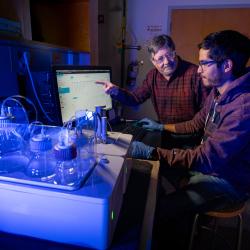Senior Chemistry Major Creates Model to Simulate Molecular Energy Transfer
Matthew Laskowski enjoys the “simple things in life”—like theoretical chemistry and trail running.
When Laskowski runs, he solves problems in his head. The senior chemistry major at the University of Maryland is a member of the club running team and gets himself in the zone by thinking about his research.
Since 2019, Laskowski has been studying the chemical dynamics of high-energy molecules with Chemistry and Biochemistry Professor Amy Mullin.
Mullin and her students create molecules in high-energy rotational states with an optical centrifuge, using intense pulses of light to trap molecules and cause them to spin with very high energy.
“The optical centrifuge is massive. It’s an entire room of lasers going back and forth, and it’s really intimidating at first when you walk in there,” Laskowski said. “In our optical centrifuge experiments, a laser pulse creates an electric field, and that field spins molecules to high rotational states—all so we can study the dynamics of these molecules.”
While the molecules are rapidly spinning, Mullin and her students study how this rotation affects atom bonds and how energy is shared by collisions with other molecules. Understanding molecules in high-energy environments is useful for uncovering answers to mysteries in areas like astrophysics and planetary atmospheres.
Solving Problems on the Run
“Running is really simple and it lets my mind flow,” Laskowski said. “My mind is most productive when I’m running.”
Chemistry and Biochemistry Assistant Professor Pratyush Tiwary, who is also an avid runner, knows the feeling.
“Going for a run clears up mental blocks as I’m working through the many projects in my group,” Tiwary said. “Many big picture ideas, or just fresh perspectives, seem to come to me during runs.”
In fall 2020, when Tiwary asked whether any students in his physical chemistry course would help run a marathon with him, Laskowski stepped up to the challenge. At about 6 a.m. on a crisp Saturday in November, Laskowki joined Tiwary for the final 10 miles of his 26.2 mile run at nearby Lake Artemesia.
“He was at the hard stage of the marathon, and he gave me instructions, ‘Just talk to me about science, distract me, keep talking,’” Laskowski recalled.
Thanks in part to Laskowski’s effective distraction, Tiwary improved his personal marathon record by 28 minutes. Now, the two keep in touch primarily through the running app Strava, but Tiwary also heard through the grapevine from other faculty members about Laskowski’s success in the classroom and the lab.
“Hearing about Matt’s success in his courses and research really shows the caliber of our undergrads and their potential to become future scientific leaders with the right level of rigorous training and detailed mentorship,” Tiwary said.
Capitalizing on Research Opportunities
When Laskowski arrived at UMD as a freshman, he knew from his dad (Mathematics Professor Chris Laskowski) that if he wanted to get involved with research on campus, all he had to do was ask.
“Matthew sent me an email asking about undergraduate research opportunities, and he’s made contributions in the lab right from the start,” Mullin said. “His questions have shown that he thinks deeply about the subject and prompted important discussions.”
When the pandemic restricted lab access last year, Laskowski proposed using computer modeling to simulate the high rotational energy transfer data that he had been helping to collect via the optical centrifuge. He worked with Mullin and Distinguished University Professor of Chemistry and Biochemistry Millard Alexander to code differential equations to simulate the evolution of the molecules’ energy over time.
Laskowski is now working with Mullin and Alexander to write a paper on the optical centrifuge experiment and his simulation’s findings. When it’s published, he’ll be listed as the first author.
“Matthew led this project from the start,” Mullin said. “He wrote the code to simulate the energy transfer events, he dove into literature to get the necessary rate constants and is now running the code with different parameters and for different systems to uncover the underlying phenomena. And beyond even that, his combination of intelligence, curiosity, persistence and humor make him a joy to work with.”
Through this work with Mullin and Alexander, as well as a summer research experience at the University of Utah, Laskowski rediscovered his passion for math through theoretical chemistry.
“Theoretical chemistry is clean—either the data is good or it isn’t,” Laskowski said. “I like the consistency and pace of theoretical research. I’m shaking my head right now because I absolutely dreaded writing code when I first started two years ago. But once it clicked, I became obsessed.”
After he graduates in December 2022, Laskowski plans to apply to graduate programs out west, where he can spend his free time running trails in the mountains—and solve chemistry problems in his head along the way.
Written by Katie Bemb







